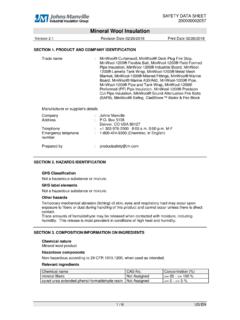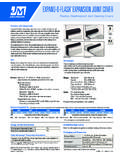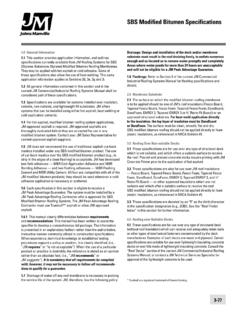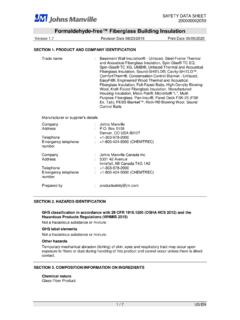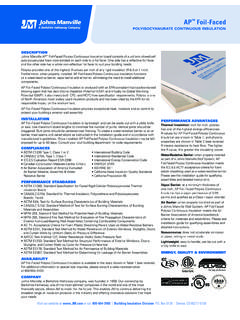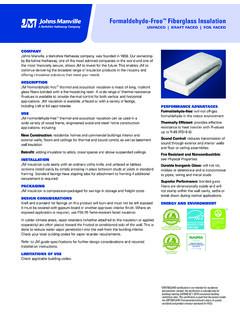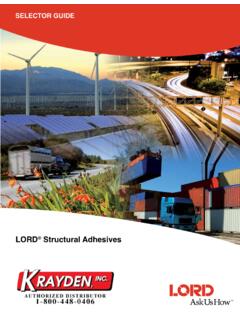Transcription of Asphalt-Applied and Cold Application Built-Up Roofing ...
1 Built-Up Roofing Application GuideTWOSECTION2-1RS-4927 2-14 (Replaces 11-13) General The following section provides the Application specifications currently available from Johns Manville (JM) for Built-Up Roofing membranes and covers both hot asphalt and cold adhesive applications included in this Application guide . Note: For the most current information on general guidelines, please refer to the System Considerations tab under Systems Introduction & Selection on the JM Roofing Web site. For specifications, flashing details and general installation information please refer to the System Application All general instructions contained in this guide book and the current JM Commercial Roofing Product Manual should be considered part of this specification. Specifications are available for systems installed over insulation, nailable, non-nailable and lightweight insulating fill substrates.
2 JM offers systems that can be installed in hot asphalt and cold For hot applied Built-Up Roofing system applications , JM-approved asphalt is required. Asphalts are thoroughly evaluated before they are approved for use in any JM Built-Up Roofing system. JM acknowledges that some specifiers choose to use coal tar pitch in Built-Up Roofing systems. However, the use of coal tar pitch is not eligible for use within JM Peak Advantage Each specification in this section is eligible to receive a JM Peak Advantage Guarantee. The system must be installed by a JM Peak Advantage Roofing Contractor that is approved for Built-Up Roofing systems. Refer to the information on guarantees in Section of the current JM Commercial Roofing Product Manual, or contact the nearest JM sales This manual clearly differentiates between requirements and recommendations. This manual has been written to assist the specifier to develop a comprehensive bid package.
3 The information is presented in an explanatory fashion rather than the authoritative, instructive manner commonly utilized in construction specifications. When experience, technical knowledge or established testing procedures support a policy or position, it is clearly identified, ( , JM requires or is not acceptable ). When the use of a particular product or practice is undesirable or questionable, the reference is stated as an opinion rather than an absolute fact, ( , JM recommends or JM suggests ). It is mandatory that all requirements be complied with, however it may not be necessary to follow all recommendations to qualify for a Drainage of water off any roof membrane is recognized as being critical to the proper performance of any Roofing Drainage: Design and installation of the deck and/or substrate must result in the roof draining freely and to outlets numerous enough and so located as to remove water promptly and completely.
4 Areas where water ponds for more than 24 hours are unacceptable and will not be eligible for a JM Peak Advantage Flashings: Refer to Flashing Details in Section 3 of this Application Membrane The surface on which the Built-Up Roofing membrane is to be applied should be one of JM s roof insulations (Fesco, Tapered Fesco, Fesco Foam, Tapered Fesco Foam, ENRGY 3, Tapered ENRGY 3, or [13 mm] Retro-Fit Board) or an approved structural substrate. The surface must be clean, smooth, flat and dry. Built-Up Roofing should not be applied directly to foam plastic insulations, as referenced in NRCA Bulletin # Built-Up Roofing Over Non-Nailable These specifications are for use over any type of structural deck which is not nailable and which offers a suitable surface to receive the roof. Poured and precast concrete require coating with JM Concrete Primer prior to the Application of hot asphalt .
5 Precast concrete panels also require a layer of approved roof insulation prior to installing a roof and cold Application Built-Up Roofing Application GuideBuilt-Up Roofing Application GuideTWOSECTION2-2RS-4927 2-14 (Replaces 11-13) Asphalt-Applied and cold Application Built-Up Roofing Application These specifications are also for use over JM roof insulations (Fesco, Tapered Fesco, Fesco Foam, Tapered Fesco Foam, ENRGY 3, Tapered ENRGY 3 and [13 mm] Retro-Fit Board) or other approved insulations that offer a suitable surface to receive the roof. Built-Up Roofing should not be applied directly to foam plastic insulations, as referenced in NRCA Bulletin #9. These specifications are not to be used over light-weight insulating concrete decks or over a fill made of lightweight insulating Non-nailable specifications are denoted by an I as the third character in the specification designation ( , 4 GIG).
6 See the Roof Finder Index on page 2-16 of this book for more Built-Up Roofing Over Nailable These specifications are for use over any type of structural deck (without insulation) which can receive and adequately retain nails or other types of mechanical fasten-ers recommended by the deck manufacturer. Examples of such decks are wood and plywood. Certain specifications are eligible for use over lightweight insulating concrete decks or over fill made of lightweight insulating concrete. Contact a JM Technical Services Specialist for approval of the lightweight fill to be Nailable specifications are denoted by an N or an L as the third character in the specification designation ( , 4 GNG, 4 GLG). See the Roof Finder Index on page 2-16 of this book for more One ply of sheathing paper must be used over wood board decks under the base All of the specifications in this section require the use of a nailable base felt.
7 Use nails or fasteners appropriate to the type of deck. See the Roof Decks section of the current JM Commercial Roofing Product Application of The proper Application of Roofing materials is as important to the satisfactory performance of the roof membrane as the materials themselves. JM suggests the following guidelines for Application of all Roofing materials. A. Wet or damaged materials should not be Never apply any Roofing materials during rain or snow, or to wet surfaces. Moisture trapped within the Roofing system as a result of this can cause severe damage to the roof membrane and Review the guidelines for Application of Roofing , roof insulations, coatings and accessories shown in this guide and the current JM Commercial Roofing Product Always start Application at the low edge of the roof per the individual specification Good Roofing procedure restricts the Application of hot asphalt to a maximum of 6 ( m) in front of the When using mechanical felt laying equipment, be sure that all orifices are All Roofing ply felts should be well set into the hot asphalt utilizing a squeegee or some other Take special care when applying coated felts in cold weather.
8 Roll out and cut all mineral surface BUR felts to specified lengths and allow them to flatten. Check the temperature of the asphalt at the mop or asphalt spreader to determine that it is at the proper Application temperature. Do not apply mineral-surfaced cap sheet when the air temperature is below 50 F (10 C).I. Do not mix different grades of asphalt or dilute asphalt with any Heat the asphalt according to the manufacturer s recommendations. Check the temperature of the asphalt at the kettle and at the point of Application . Have accurate thermometers on all Roofing kettles. Adhere to the guidelines for the heating of asphalts in this section of the Roofing Application GuideTWOSECTION2-3RS-4927 2-14 (Replaces 11-13)K. Always use the proper grade asphalt . A good guideline to follow regarding the use of asphalt is Use the softest grade of asphalt commensurate with the slope and climatic conditions.
9 L. Always install water cutoffs at the end of each day s work to prevent moisture infil-tration into the completed work area. Water cut-offs should be completely removed prior to resuming work. M. Heed the cold weather Application procedures in paragraph of this Always install the complete Roofing system at one time. Phased construction may result in slippage of felts due to excessive amounts of asphalt between the phased plies. Blisters due to entrapment of moisture, or poor adhesion of the membrane due to dust and foreign material collecting on the exposed felts, are other hazards of phased It is essential that traffic be minimized on a freshly laid roof, while the asphalt is still fluid. Asphaltic displacement through the porous fiber glass ply felts can result from rooftop traffic during asphalt set time. Depending on specific job factors, this set time can be as long as 45 minutes.
10 Asphaltic displacement can result in phantom leaks and blistering of the Always comply with published safety procedures for all products being used. See the Introduction section of the current JM Commercial Roofing Product Manual, MSDS and container labels for health and safety Roofing JM manufactures different fiber glass Roofing felts for a variety of Roofing needs: felts for flashings, vapor retarders, roof plies, base sheets and special felts for Roofing felts are furnished in rolls consisting of one or more squares. A factory square of Roofing contains sufficient material to cover 100 ft2 ( m2) of roof surface accounting for nominal side and end Roofing Roofing asphalts are available in four grades, shown in paragraph of this section. In general, they are grade specified by softening point. The slope of the roof governs the grade to be used, in conjunction with the climatic constraints.

